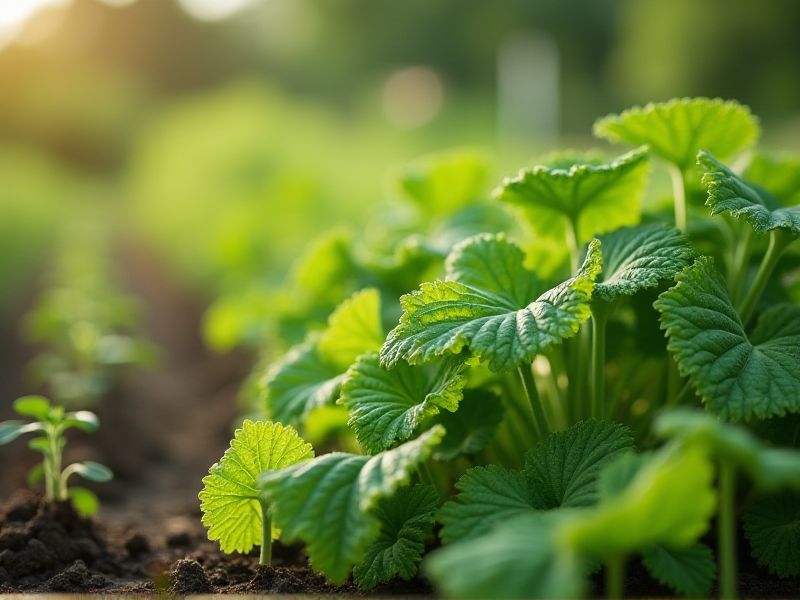
Companion planting involves pairing different plant species to enhance growth and productivity. For example, marigolds can deter nematodes and pests, promoting healthier tomato plants nearby. Basil is known to improve the flavor of tomatoes and repel harmful insects like aphids. Legumes, such as beans, fix nitrogen in the soil, benefiting adjacent crops like corn or squash. Incorporating these effective companion plants can not only increase your yield but also create a more diverse and resilient garden ecosystem.
List of some Companion plants that boost crop production
- Basil (Ocimum basilicum) - Tomatoes (Solanum lycopersicum)
- Marigold (Tagetes spp.) - Peppers (Capsicum spp.)
- Borage (Borago officinalis) - Strawberries (Fragaria × ananassa)
- Chives (Allium schoenoprasum) - Carrots (Daucus carota subsp. sativus)
- Dill (Anethum graveolens) - Cabbage (Brassica oleracea)
- Nasturtium (Tropaeolum majus) - Cucumbers (Cucumis sativus)
- Mint (Mentha spp.) - Cabbage (Brassica oleracea)
- Sage (Salvia officinalis) - Carrots (Daucus carota subsp. sativus)
- Lavender (Lavandula spp.) - Apples (Malus domestica)
- Cilantro (Coriandrum sativum) - Spinach (Spinacia oleracea)
Important things about Companion plants that boost crop production
Pest Control
Companion planting involves pairing plants that mutually benefit each other, enhancing your garden's overall health and productivity. For example, marigolds are known to repel nematodes and aphids, making them an excellent companion for vegetables like tomatoes and peppers. Basil, when planted alongside tomatoes, not only boosts flavor but also attracts beneficial insects while deterring pests such as whiteflies. Incorporating these strategic plant alliances can lead to a more abundant harvest and reduce the need for chemical pesticides in your garden.
Nutrient Enhancement
Companion planting is a strategic agricultural practice that involves pairing certain plants to enhance nutrient uptake, pest control, and overall crop yields. For instance, legumes like beans and peas fix nitrogen in the soil, benefiting nutrient-hungry plants like corn and tomatoes when planted nearby. Herbs such as basil and marigold not only repel pests but also attract beneficial insects that promote pollination and improve plant health. By strategically selecting companion plants, you can create a thriving ecosystem in your garden, leading to increased crop production and sustainability.
Soil Improvement
Companion plants, such as marigolds and legumes, enhance soil fertility and boost crop production by fostering beneficial microbial activity. By fixing nitrogen in the soil, legumes improve nutrient availability for adjacent crops, while marigolds repel harmful pests. Integrating these plants into your gardening or farming practices can lead to a healthier ecosystem, reducing the need for chemical fertilizers and pesticides. Additionally, the diverse root systems of companion plants can improve soil structure and aeration, promoting better water retention and overall plant health.
Growth Stimulation
Companion planting is a strategic agricultural practice where specific plant types are grown together to enhance growth, yield, and pest resistance. For instance, planting marigolds alongside tomatoes can deter nematodes, while beans fix nitrogen in the soil, benefiting neighboring plants. Utilizing herbs like basil can improve the flavor of nearby vegetables and repel harmful insects. By incorporating companion plants such as carrots with onions, you can maximize space and promote a flourishing garden that supports sustainable crop production.
Pollinator Attraction
Companion planting with pollinator-attracting species significantly enhances crop production by improving pollination and increasing biodiversity in your garden. Incorporating flowers like borage, lavender, and marigolds alongside vegetables such as squash and tomatoes can draw bees and butterflies, which are essential for fruit and seed formation. These companion plants not only provide nectar and pollen but also can deter pests, protecting your crops from damage. By creating a diverse ecosystem with these plants, you can enjoy more abundant harvests while supporting local pollinator populations.
Space Efficiency
Companion planting enhances crop production by utilizing space efficiently and improving plant health. For instance, planting basil alongside tomatoes can deter pests and enhance flavor through beneficial microbial interactions. Additionally, legumes, like beans, fix nitrogen in the soil, enriching it for neighboring plants. You can optimize your garden by incorporating these pairings to maximize yield while minimizing the need for chemical fertilizers.
Disease Resistance
Companion planting involves strategically pairing certain plants to enhance growth, improve disease resistance, and increase overall crop yield. For instance, planting marigolds alongside tomatoes can deter pests such as nematodes, reducing the risk of disease and promoting healthier plants. Similarly, the combination of basil with peppers is known to enhance flavor while simultaneously repelling harmful insects. By incorporating companion plants, you can create a more resilient garden ecosystem that maximizes both production and natural pest control.
Weed Suppression
Companion planting involves strategically pairing crops with specific plants to enhance growth, deter pests, and suppress weeds. For example, planting marigolds alongside vegetables can naturally repel nematodes and aphids, while their dense foliage shades the soil, reducing weed competition. Utilizing cover crops like clover or vetch not only improves soil health but also prevents weed germination by outcompeting them for space and nutrients. By incorporating these companion plants into your garden, you can significantly boost crop production and maintain a healthier ecosystem.
Microclimate Creation
Companion planting enhances microclimates, promoting beneficial interactions between plants that can significantly boost crop production. For example, planting marigolds alongside tomatoes not only deter pests but also improve soil health through their root exudates. Additionally, legumes, such as beans or peas, fix nitrogen in the soil, enriching nutrient availability for neighboring crops like corn or squash. By strategically selecting companion plants, you can create a thriving microclimate that optimizes growth conditions and maximizes your harvest.
Biodiversity Promotion
Companion planting leverages the synergistic relationships between different plant species to enhance crop production and promote biodiversity. For example, planting nitrogen-fixing legumes alongside heavy feeders like corn can enrich soil fertility while minimizing the need for synthetic fertilizers. Additionally, incorporating companion plants such as marigolds can deter pests and attract beneficial insects like pollinators, leading to healthier ecosystems. By strategically pairing crops, you can create a thriving garden that optimizes space and resources while fostering a diverse biological community.
